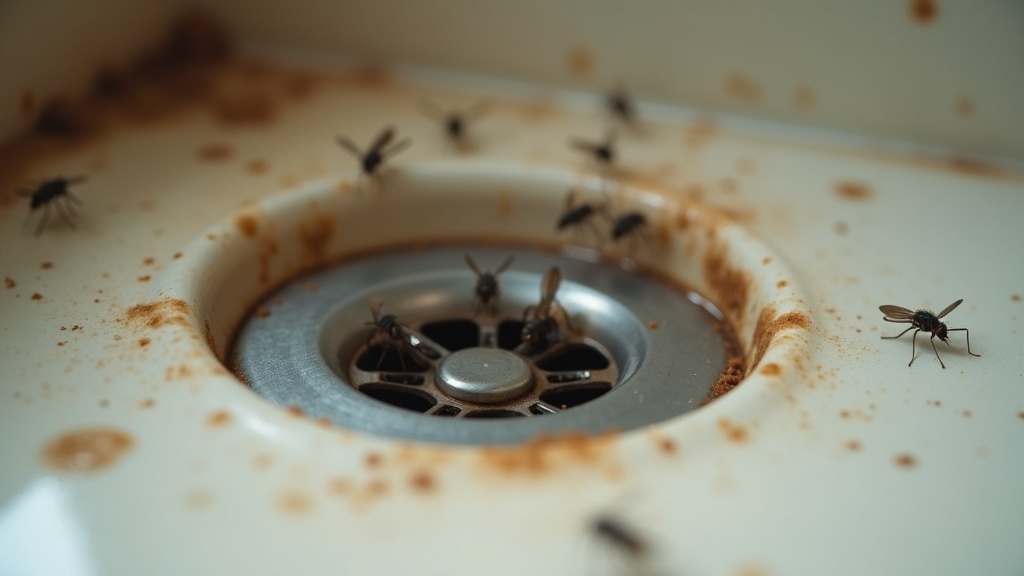Gnats swarming out of your RV drains can turn a relaxing trip into an annoying battle. I’ve faced gnat invasions more times than I’d like to admit, so I know how frustrating these little pests can be. They love warm, damp places, which makes your RV’s drains a perfect hangout spot. Whether you’re new to RV life or have been on the road for years, these tips and tricks should help you get rid of gnats in your RV drains once and for all.

Why Do Gnats Infest RV Drains?
Gnats, especially drain flies and fungus gnats, are drawn to places where they can find moisture and decaying organic material. The combination of leftover food particles, hair, and soap in RV sinks and shower drains creates a perfect feeding ground. Compared to a stationary house, the limited plumbing in an RV can make the problem seem worse because gunk builds up faster and ventilation isn’t as good.
Drain gnats aren’t just gross; they often mean there’s a buildup of debris somewhere in your pipes. The bugs themselves aren’t dangerous, but a gnat-filled drain is a sign your RV’s plumbing needs some love. Regular maintenance can save you from bigger plumbing headaches and keep the bugs at bay.
Identifying Gnats in RV Drains
Several types of gnats may pop up in your RV’s drains:
- Drain Flies: Also called sewer flies or moth flies, these tiny insects look fuzzy and hang around the sink. They lay eggs in the slimy gunk inside drains.
- Fungus Gnats: These guys are more likely to show up if you have potted plants in your RV, but sometimes, they explore the drains, especially if there’s decaying matter.
- Fruit Flies: If you keep fruit or unsealed food on your counter, fruit flies may use nearby drains as a home base.
You’ll notice them flying up and out of the drains, or even clustering around your sink or shower. They’re most active in the evening when humidity is high.
Easy Steps to Get Rid of Gnats in RV Drains
Dealing with gnats right away will help avoid a full-on infestation. Here’s a practical step-by-step rundown of what’s worked well for me:
- Boiling Water Flush: Pour a kettle of boiling water down the affected drain each morning and evening for a few days. This helps break down any organic buildup and can kill eggs and larvae on contact.
- Baking Soda and Vinegar: Sprinkle about half a cup of baking soda into the drain, then follow with a cup of vinegar. Let it fizz for at least 30 minutes before flushing with more boiling water. This combo helps clear sticky grime inside the pipes.
- Physical Cleaning: If your RV’s plumbing design allows, remove and clean the drain trap. Pull out any gunk using a brush or old toothbrush. I like to wear disposable gloves for this part.
- Enzyme Cleaners: Enzyme based drain cleaners are really good for breaking down organic material without harsh chemicals. Pour one down the drain at night and give it plenty of time to work.
- Trap and Block: While you’re treating the drain, plug it with a stopper when not in use. This stops gnats from coming up into your living area.
Treat all your drains at once—even if you only spot bugs in one, since gnats spread quickly throughout the plumbing.
Preventing Gnat Problems in the Future
Prevention is super important if you want to keep gnats from coming back. Here are some habits and tips that help keep drain gnats from moving in:
- Rinse Sink Thoroughly: After every use, run plenty of water to push food scraps and debris far down the line, and use the sink strainer to catch anything big before it goes down the drain.
- Weekly Drain Flush: Make it a habit to pour a gallon or two of hot water down each drain every week, especially if you spend a lot of time camping offgrid where holding tanks get less use.
- Ventilation Matters: Open windows or run a vent fan when using the shower or kitchen to lower humidity. Gnats love damp, still air.
- Tank Maintenance: Regularly clean black and gray tanks with the right RV safe chemicals or enzyme treatments. Even if the gnats show up in a sink, they can be breeding in the tanks.
- Watch for Leaks: Fix any small leaks under sinks or in cabinets as soon as possible, since standing water is a gnat magnet.
Simple steps like these keep the drains and plumbing clear, while making your RV less attractive to pests. You might also want to use mesh screens or covers for any openings, especially when you’re parked in bugheavy environments. This simple barrier can make a big difference over time.
Common Hurdles When Fixing a Gnat Problem
I’ve noticed a few things that can make getting rid of gnats more frustrating than expected:
- Narrow Space: RV sinks and trap pipes are usually packed under cabinets or counters, making deep cleaning a bit of a hassle.
- Tank Build Up: If holding tanks aren’t flushed often, the whole plumbing system gets gunked up, meaning gnats keep coming back, no matter how well you clean the sink.
- Persistent Humidity: Traveling or camping in a muggy climate, or even just running the shower with windows closed, makes it hard to dry things out.
- Multiple Entry Points: If you only treat one drain and ignore others, gnats might just move around and return later.
With some patience and a habit of deep cleaning, I’ve found you can stay ahead of even the most stubborn gnat problems. Don’t get discouraged if you see a few bugs for another day or two; they’re persistent but beatable. If you do see gnats lingering after repeated cleans, consider checking hidden or hardtoreach plumbing areas where builtup debris may have gone unnoticed.
Enzyme Cleaners vs. Chemical Cleaners
Chemical drain cleaners are tempting, but I suggest using enzyme based stuff instead. Enzyme products break down organic gunk without ruining your pipes or tanks, which is important in an RV’s sensitive plumbing system. Plus, they’re better for the environment, especially if your wastewater ends up in a campground septic system.
Dealing with Gnats on the Road
Gnats can sneak in while you’re stopped at grassy or wooded campsites. If you travel fulltime, dealing with them becomes an ongoing chore. It’s worth it to sweep out all food crumbs, refrigerate fruit, and keep screens on windows and vents shut when you’re parked in buggy spots. Sometimes, the best fix is simple: keep things clean and dry, and the gnats will have nowhere to call home. But if you start noticing gnats in odd places, check areas near your RV’s water connections or outside storage bays, since moisture sometimes builds up there without you realizing it.
Handy Supplies for Keeping Drains GnatFree
I like to stock up on these items for regular RV drain maintenance:
- Sturdy drain brush or old toothbrush
- Disposable gloves
- Baking soda and white vinegar
- Kettle for boiling water
- Enzyme based cleaner (RVsafe)
- Rubber drain stoppers
- Mesh screens for windows or vents (optional but helpful)
With these supplies, you can quickly react to new gnat problems or keep the plumbing fresh as part of your routine cleaning. Having a checklist handy for these tasks ensures nothing gets missed on longer trips, helping maintain a pestfree space.
Frequently Asked Questions
Here are some of the most common questions about getting rid of gnats in RV drains:
Question: Will bleach kill gnats in my RV drain?
Answer: Bleach can disable some adult gnats and bacteria, but it’s not great for the plumbing and won’t always remove the organic debris where gnats lay eggs. I stick with enzyme treatments and physical cleaning instead.
Question: How long does it take to get rid of gnats in RV drains?
Answer: If you treat all the drains and keep things clean and dry, you should see a big drop in gnats within a few days. Repeat treatments and regular maintenance keep them away for good.
Question: Are gnats a sign of more serious plumbing issues?
Answer: Not always, but seeing a lot of gnats could mean your drains or tanks are clogged and need a deep clean. If gnats keep coming back despite cleaning, it’s worth checking for leaks or heavy buildup in your gray and black tanks.
Question: What should I do if gnats appear in my RV after a heavy rain?
Answer: Keep all windows and doors closed during and after the rain and inspect all drains and moistureprone spots for gnats. Increase your cleaning efforts after a storm, since extra humidity attracts these pests.
Question: How do I stop gnats from entering when camping in highbug areas?
Answer: Always use screens on vents and doors, close drains when not in use, and limit the number of open containers. Promptly clean up spills and crumbs, and set out apple cider vinegar traps outside if they’re especially heavy in your spot.
Final Thoughts
Cleaning RV drains and staying ahead of bugs is a neverending part of RV life. A simple routine using natural cleaners and a little elbow grease will keep your drains bugfree so you can get back to enjoying the road. Keep things clean, well ventilated, and dry, and those gnats will have to look somewhere else for a home base.
